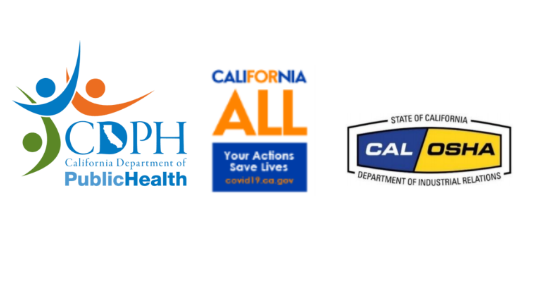Title Page
-
Conducted on
-
Prepared by
-
Location
Contents of Written Worksite Specific Plan
-
The person(s) responsible for implementing the plan.
-
A risk assessment and the measures that will be taken to prevent spread of the virus.
-
Training and communication with employees and employee representatives on the plan.
-
A process to check for compliance and to document and correct deficiencies.
-
A process to investigate COVID-cases, alert the local health department, and identify and isolate close workplace contacts of infected employees until they are tested.
-
Update the plan as necessary to prevent further cases.
-
Incorporate COVID-19 preparation into emergency response plans; have worksite-specific emergency plans to operate safely during emergencies.
Topics for Employee Training
-
Information on COVID-19, preventing spread, and who is especially vulnerable. <br>https://www.cdc.gov/coronavirus/2019-ncov/index.html
-
Self-screening at home, including temperature and/or symptom checks using CDC guidelines.<br>https://www.cdc.gov/coronavirus/2019-ncov/symptoms-testing/symptoms.html
-
The importance of not coming to work if employees have a frequent cough, fever, difficulty breathing, chills, muscle pain, headache, sore throat, the recent loss of taste or smell, or if they or someone they live with has been diagnosed with COVID-19.
-
When to seek medical attention.
-
The importance of hand washing.
-
The importance of physical distancing, both at work and off work time.
-
Proper use of cloth face covers
Individual Control Measures and Screening
-
Symptom screenings and/or temperature checks.
-
Encourage workers who are sick or exhibiting symptoms of COVID-19 to stay home.
-
Encourage frequent handwashing and use of hand sanitizer.
-
Provide disposable gloves to workers using cleaners and disinfectants if required. Consider gloves a supplement to frequent hand washing for other cleaning, tasks such as handling commonly touched items or conducting symptom screening.
-
Strongly recommend use of cloth face covers.
-
Restrict non-employees entering facilities and conduct temperature and/or symptom screening. Encourage non-employees to wear face covers.
-
Equip crews and field technicians with supplies and required protective equipment.
Cleaning and Disinfecting Protocols
-
Perform thorough cleaning in high traffic areas.
-
Frequently disinfect commonly used surfaces.
-
Clean and sanitize shared equipment between each use.
-
Clean touchable surfaces between shifts or between users, whichever is more frequent.
-
Avoid sharing phones, office supplies, other work tools, or handheld mobile communications equipment wherever possible.
-
Ensure that sanitary facilities stay operational and stocked at all times.
-
Provide sanitary supplies including hand sanitizer and make sure it is readily available to employees.
-
Use products approved for COVID-19 on the Environmental Protection Agency (EPA)-approved list and follow product instructions and Cal/OSHA requirements.<br>https://www.epa.gov/pesticide-registration/list-n-disinfectants-use-against-sars-cov-2
-
Sanitize personal equipment at the end of shift.
-
Provide time for workers to implement cleaning practices before and after shifts. If cleaning is assigned to the worker, they must be compensated for that time.
-
Install hands-free devices if possible.
-
Consider upgrades to improve air filtration and ventilation.
-
Modify offerings in any on-site cafeterias or dining rooms, including using prepackaged foods, and non-touch options for a drink, condiment, and flatware dispensing.
Physical Distancing Guidelines
-
Implement measures to physically separate workers by at least six feet using measures such as physical partitions or visual cues (e.g., floor markings, colored tape, or signs to indicate to where workers should stand).
-
Develop a process workflow with questions and talking points for employees to use at the customer’s door to identify suspected COVID-19 concerns
-
Allow field staff to call a “safety stop” when they are reluctant to enter a dwelling.
-
Contact customers before visits to confirm appointments and check if there are infected people on-premises, check again when workers are at the door.
-
Use remote diagnostics and self-install/repair strategies wherever possible.
-
Adjust meetings to ensure physical distancing.
-
Utilize work practices, when feasible, to limit the number of workers on-site at one time.
-
Stagger employee breaks, in compliance with wage and hour regulations, to maintain physical distancing protocols.
-
Reconfigure, restrict or close breakrooms and create alternative space for breaks where physical distancing is possible.
-
Provide separate, designated entrances, and exits.
-
Reassign lockers or limit or stagger locker use to increase the distance between employees.
-
Use remote work arrangements when feasible.
-
Take extra precautions for field workers operating in a restricted area or containment zone.
-
Conduct daily safety briefings.
-
For work performed at healthcare facilities or other higher-risk locations, arrange cleaning and physical distancing in advance.
-
Outside visitors should not be allowed in control centers.
-
Consider which personnel can perform their jobs in spaces adjacent to an existing control room.
-
Consider control room functions that can be performed remotely.
-
Control center support staff (engineering, transmission scheduling, compliance, etc.) should be allowed to work remotely to the extent permissible.
-
Workstations should allow for at least six feet of space between employees.
-
Conduct temperature and/or symptom screening for contractors.
-
Develop contingency plans to house operators onsite, including bedding, hygiene facilities, entertainment, and food accommodations.
Sign Off
-
Name and Signature
















